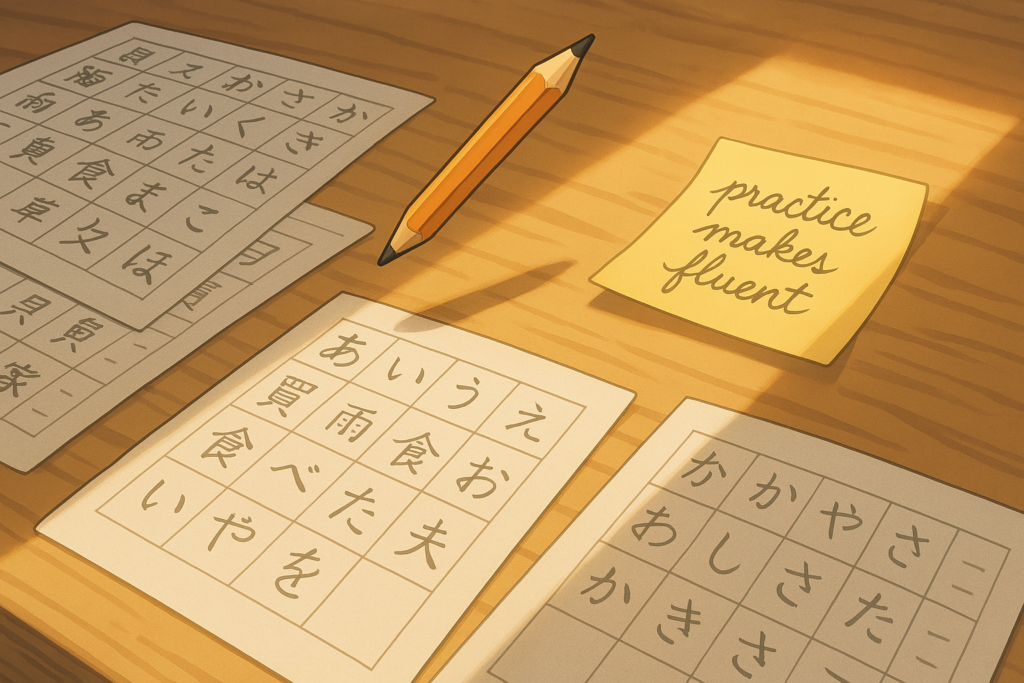Have you ever found yourself staring at a Japanese textbook, wondering how to refer to those practice questions at the end of each chapter? Understanding how to say “exercise” in Japanese is essential whether you’re a student, teacher, or self-learner navigating Japanese educational materials. In this comprehensive guide, we’ll explore the various Japanese terms for exercises, their nuances, and how to use them correctly in academic settings.
What “Exercise” Means in Japanese Academic Contexts
In Japanese educational settings, several terms are used to refer to what we call “exercises” in English. Each has its own nuance and appropriate context, making it important to choose the right word for your specific situation.
練習問題 (Renshū mondai) – Practice Problems
The most common term for textbook exercises is 練習問題 (renshū mondai), which literally translates to “practice problems.” This term is widely used in Japanese schools, universities, and language learning materials.
Example usage:
- 今日はこの練習問題だけやります。(Kyō wa kono renshū mondai dake yarimasu.)
- “Today, we will only do this exercise.”
- 203ページの1と2の練習問題を終わらせてください。(203 pēji no 1 to 2 no renshū mondai o owarasete kudasai.)
- “Please complete exercises 1 and 2 on page 203.”
問題 (Mondai) – Problems/Questions
Often, 練習問題 is shortened to simply 問題 (mondai), especially in classroom settings. This term can refer to any type of problem or question in a textbook.
Example usage:
- 問題2に答えてください。(Mondai ni ni kotaete kudasai.)
- “Please answer exercise number two.”
- 次の問題を解いてみましょう。(Tsugi no mondai o toite mimashou.)
- “Let’s try solving the next exercise.”
演習 (Enshū) – Practical Exercises
演習 (enshū) refers to practical exercises or drills, often used in more advanced academic settings like university courses. This term carries a nuance of applying knowledge practically.
Example usage:
- 演習を通して文法を習得します。(Enshū o tōshite bunpō o shūtoku shimasu.)
- “We will master grammar through exercises.”
- この演習は難しいかもしれませんが、大切です。(Kono enshū wa muzukashii kamo shiremasen ga, taisetsu desu.)
- “This exercise might be difficult, but it’s important.”
How to Refer to Different Types of Exercises in Japanese
Different learning contexts require different terminology. Let’s explore how to refer to various types of exercises you might encounter.
Written Exercises in Textbooks
For written exercises in textbooks, the most appropriate terms are:
- 練習問題 (renshū mondai) – General practice problems
- 問題 (mondai) – Problems/questions
- 演習 (enshū) – Applied exercises (more common in university settings)
Spoken Language Practice
For conversational practice or role-playing:
- 練習 (renshū) – Practice
- 会話練習 (kaiwa renshū) – Conversation practice
- エクササイズ (ekusasaizu) – Exercise (loanword, sometimes used in modern language textbooks)
Example Exercises or Demonstrations
When referring to example exercises that demonstrate a concept:
- 例題 (reidai) – Example problem
- 練習例 (renshū rei) – Practice example
As we noted in our Wakatta Meaning Explained post, context is crucial when learning Japanese terminology. The same applies when discussing exercises in Japanese educational settings.
Common Phrases for Classroom Instructions About Exercises
Learning how to give and understand instructions about exercises is essential for successful language learning. Here are some common phrases:
- 問題を解きなさい。(Mondai o tokinasai.) – “Solve the problems.”
- 練習問題を終わらせてください。(Renshū mondai o owarasete kudasai.) – “Please complete the exercises.”
- 次の演習に移りましょう。(Tsugi no enshū ni utsurimashou.) – “Let’s move on to the next exercise.”
- 練習問題の答え合わせをしましょう。(Renshū mondai no kotae awase o shimashou.) – “Let’s check the answers to the exercises.”
- 問題番号2を見てください。(Mondai bangō ni o mite kudasai.) – “Please look at exercise number two.”
Just as we explored in our guide on Donna Meaning in Japanese, understanding question formats is essential for Japanese learners. Exercises often contain various question types that use words like どんな (donna) to prompt specific responses.
Exercise Numbers and Page References in Japanese
Knowing how to refer to specific exercises and page numbers is crucial when navigating Japanese textbooks:
Exercise Numbers
When referring to specific exercise numbers:
- 問題1 (mondai ichi) – “Exercise 1”
- 第2問 (dai ni mon) – “Question 2” (more formal)
- 2番 (ni ban) – “Number 2”
Page References
For page references:
- 203ページの問題 (nihyaku san pēji no mondai) – “The exercise on page 203”
- 次のページの練習問題 (tsugi no pēji no renshū mondai) – “The exercise on the next page”
The Difference Between 練習 (Renshū) and エクササイズ (Ekusasaizu)
While both terms can translate to “exercise” in English, they have different connotations:
- 練習 (renshū) primarily refers to practice or training in various contexts. It’s commonly used for:
- Sports training (サッカーの練習 – soccer practice)
- Music practice (ピアノの練習 – piano practice)
- Language practice (日本語の練習 – Japanese practice)
- エクササイズ (ekusasaizu) is a loanword that typically refers to:
- Physical exercises (ヨガのエクササイズ – yoga exercises)
- Workout routines (朝のエクササイズ – morning exercises)
- Some modern language textbooks may use this term for activities
In academic contexts, 練習問題 or 問題 are much more common than エクササイズ when referring to textbook exercises.
Tips for Completing Japanese Textbook Exercises
To maximize your learning through Japanese exercises:
- Read instructions carefully – Japanese instructions often contain crucial grammatical clues.
- Look for example answers (解答例 – kaitō rei) when provided.
- Practice writing full sentences rather than just filling in blanks.
- Review mistakes thoroughly – understanding errors is key to improvement.
- Apply what you’ve learned in real conversations, as we suggested in our Hazukashii Meaning guide.
Q&A: Common Questions About Exercises in Japanese
What’s the most common way to say “exercise” for textbook activities in Japanese?
The most common term for textbook exercises in Japanese is 練習問題 (renshū mondai).
How do I refer to exercise number 2 in a Japanese textbook?
You would say 問題2 (mondai ni) or 2番の問題 (ni ban no mondai).
Can I use エクササイズ (ekusasaizu) to refer to language learning exercises?
While エクササイズ is sometimes used in modern contexts, 練習問題 (renshū mondai) or 問題 (mondai) are more common and appropriate for academic exercises.
What’s the difference between 練習問題 (renshū mondai) and 例題 (reidai)?
練習問題 refers to practice problems students complete independently, while 例題 typically refers to example problems used to demonstrate concepts before students practice on their own.
Conclusion: Mastering Exercise Terminology in Japanese
Understanding how to refer to exercises in Japanese is a small but significant part of your language learning journey. Whether you’re a student navigating textbooks or a teacher creating materials, knowing terms like 練習問題 (renshū mondai), 問題 (mondai), and 演習 (enshū) will help you communicate more effectively in Japanese academic settings.
Want to deepen your Japanese language skills beyond exercises? Check out our free Japanese learning guides for comprehensive resources to accelerate your learning journey.
By mastering these key terms and phrases, you’ll be better equipped to engage with Japanese educational materials confidently and effectively. Remember, consistent practice with exercises is one of the most reliable paths to Japanese language proficiency!




